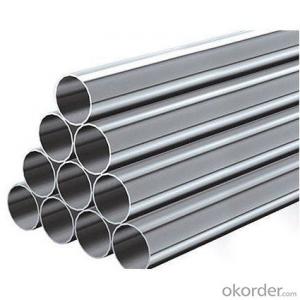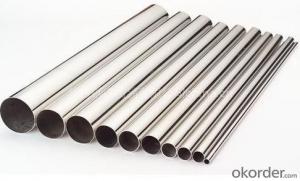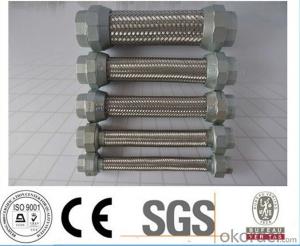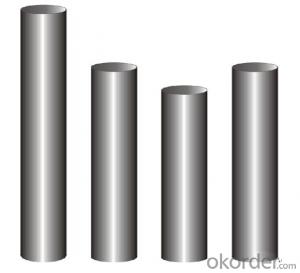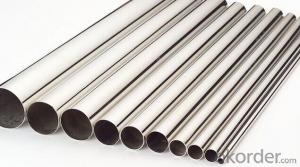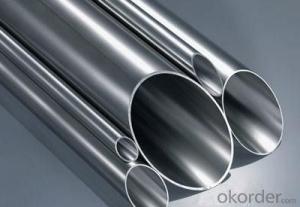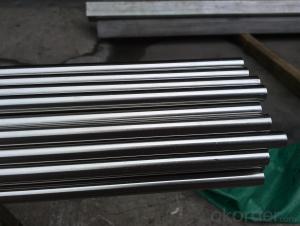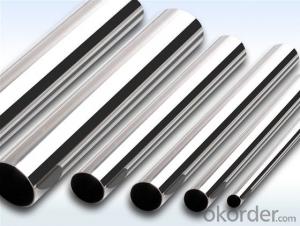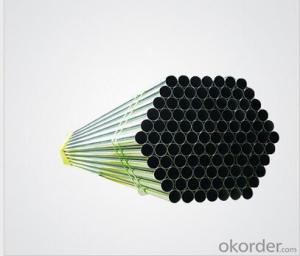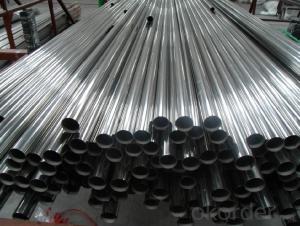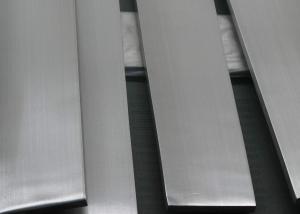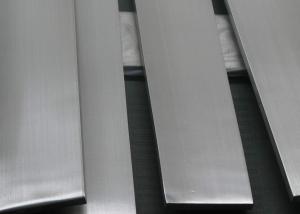ASTM A269 Seamless Stainless Steel Pipe
- Loading Port:
- Tianjin
- Payment Terms:
- TT OR LC
- Min Order Qty:
- 25 m.t.
- Supply Capability:
- 1000 m.t./month
OKorder Service Pledge
OKorder Financial Service
You Might Also Like
Quick Details
| Standard: | JIS,AISI,ASTM,DIN,EN | Place of Origin: | China (Mainland) | Brand Name: | OKORDER |
| Model Number: | stainless steel pipe | Type: | Seamless | Steel Grade: | 300 Series |
| Application: | stainless steel pipe | Certification: | ISO | Thickness: | 1-30 |
| Outer Diameter: | 6-530 | Quality: | good stainless steel pipe | Brand: | stainless steel pipe |
Packaging & Delivery
| Packaging Detail: | polywood box |
| Delivery Detail: | 35days |
Specifications
ASTM A269 Seamless Stainless Steel Pipe:
Outside diameter from 6mm to 530mm.
Wall thickness from 0.5mm to 38.1mm.
ASTM A269 Seamless Stainless Steel Pipe
1. Material | TP304/304L, 316/316L, 310S, 317L, 321, 347H,etc. |
S31803, 32750, etc. | |
2. Standard | ASTM, ASME, DIN, EN, ISO,JIS, GOST, etc. |
3. Type | Seamless |
4. Size range | OD: from 6mm to 1000mm (NPS from 1/8'' to 40'') |
WT: from 0.7mm to 38mm (Schedule from 5S to XXS) | |
Length: fix length or un-fix length, Max 30meters | |
5. Produce process | Pilgering and cold drawn |
6. Surface process | Pickling and annealing |
AP tube | |
BA tube | |
7. Marking | JW, GRADE, seamless, STANDARD, SIZE, HT NO. |
8. Package | Bundles with waterproof cloth outside. |
or plywood box. | |
9. Min order quantity | 500 KG |
10. Sample | Yes |
11. OEM accepted | Yes |
12. Production capacity | 300 tons per month |
13. Payment term | T/T or L/C. |
14. Certificate | ISO 9001, PED |
15. Third party ertificate | BV, LR, SGS, TUV, CCS, ABS, etc. |
- Q: How do you calculate the pressure rating of stainless steel pipes?
- When calculating the pressure rating for stainless steel pipes, several factors must be taken into consideration. Firstly, the material properties of the stainless steel being used, such as its yield strength and tensile strength, need to be known. These properties can be obtained from material data sheets or through conducting mechanical tests. Secondly, the wall thickness of the stainless steel pipe needs to be determined. This can be directly measured or obtained from the specifications provided by the pipe manufacturer. It is crucial to ensure that the wall thickness remains consistent throughout the entire length of the pipe. Once the material properties and wall thickness are known, the appropriate formula or calculation method can be utilized to ascertain the pressure rating. There are various codes and standards available, such as the ASME B31.3 code for process piping or the ASME B31.1 code for power piping, which offer guidance on calculating pressure ratings for different pipe types. These codes typically take into account factors such as material allowable stress, safety factors, and design considerations. The formulas or calculation methods provided within these codes consider the material properties, wall thickness, pipe diameter, and other relevant parameters to determine the maximum allowable pressure that the stainless steel pipe can withstand. It is important to note that the pressure rating of stainless steel pipes may also be influenced by other factors, including the fluid temperature, the corrosiveness of the fluid, and any potential external loads or stresses on the pipe. Therefore, it is advisable to consult the applicable codes, standards, or a qualified engineer to ensure accurate calculations and to consider all relevant factors when determining the pressure rating of stainless steel pipes.
- Q: Can stainless steel pipes be used for oil and gas transportation?
- Indeed, the utilization of stainless steel pipes for the transportation of oil and gas is plausible. Due to its exceptional resistance to corrosion and durability, stainless steel has become a favored material choice within the oil and gas industry for pipe construction. These pipes possess the capability to endure harsh circumstances, including high pressure, extreme temperatures, and corrosive surroundings, rendering them appropriate for the conveyance of oil and gas. Furthermore, the purity of the transported fluids is maintained by stainless steel pipes, as they exhibit no reactivity or contamination towards the substances being conveyed. As a result, stainless steel pipes are an unquestionably dependable and efficient option for oil and gas transportation.
- Q: Can stainless steel pipes be used for automotive exhaust systems?
- Yes, stainless steel pipes can be used for automotive exhaust systems. Stainless steel is a popular choice for exhaust systems due to its excellent corrosion resistance, high temperature strength, and durability. It can withstand the extreme heat and harsh conditions that are common in automotive exhaust systems, making it a reliable and long-lasting option. Stainless steel pipes also have a smooth surface, which helps to reduce friction and improve exhaust flow, leading to improved performance and fuel efficiency. Additionally, stainless steel is a lightweight material, which can help to reduce the overall weight of the vehicle and improve its handling. Overall, stainless steel pipes are a suitable and commonly used material for automotive exhaust systems.
- Q: Are stainless steel pipes fire-resistant?
- Yes, stainless steel pipes are fire-resistant. Due to their high melting point and excellent heat resistance, stainless steel pipes can withstand extreme temperatures and prevent the spread of fire, making them a reliable choice for fire protection systems.
- Q: What are the different types of stainless steel pipe unions?
- There are several different types of stainless steel pipe unions available, each designed for specific applications and requirements. Some of the most common types include: 1. Threaded Union: This type of union is threaded on both ends, allowing for easy installation and disassembly. It is commonly used in low-pressure applications and can withstand moderate temperatures. 2. Socket Weld Union: Socket weld unions have a socket on one end and a male threaded connection on the other. They are designed for high-pressure applications and are commonly used in industrial settings. 3. Butt Weld Union: Butt weld unions have two butt weld connections, one on each end. They are used in applications where a permanent, leak-proof connection is required, such as in pipelines carrying corrosive fluids. 4. Flanged Union: Flanged unions have flanges on both ends, allowing for easy connection to flanged pipes or equipment. They are commonly used in high-pressure and high-temperature applications that require easy installation and disassembly. 5. Compression Union: Compression unions consist of two ferrules and a nut that compresses the ferrules onto the pipe for a tight seal. They are commonly used in plumbing and gas supply systems. 6. Quick Connect Union: Quick connect unions, also known as push-to-connect unions, allow for easy and quick assembly without the need for tools or soldering. They are commonly used in plumbing, irrigation, and air compressor systems. It is important to select the appropriate type of stainless steel pipe union based on the specific requirements of the application, including the pressure, temperature, and compatibility with the fluid being transported. Consulting with a knowledgeable supplier or engineer can help ensure the correct union is chosen for the intended application.
- Q: What is the maximum temperature limit for stainless steel pipes?
- The maximum temperature limit for stainless steel pipes depends on the specific grade of stainless steel used. Generally, stainless steel pipes can withstand high temperatures ranging from 1200°F (650°C) to 1600°F (870°C). However, it is crucial to consider the specific alloy composition, as some grades of stainless steel have higher temperature resistance than others. Additionally, factors such as the duration of exposure to high temperatures and the presence of corrosive substances can also affect the maximum temperature limit. Therefore, it is essential to consult the manufacturer's specifications or seek professional advice to determine the exact maximum temperature limit for a specific stainless steel pipe application.
- Q: What are the limitations of using stainless steel pipes?
- There are several limitations associated with the use of stainless steel pipes. Firstly, stainless steel pipes tend to be more expensive compared to other materials such as PVC or copper. This can make them less feasible for projects with budget constraints. Secondly, stainless steel pipes can be more difficult to install and require specialized tools and equipment. This can increase the overall installation time and cost. Another limitation is that stainless steel pipes are not suitable for transporting certain corrosive chemicals or gases. They may react with certain substances, leading to corrosion and potential damage to the pipes. In such cases, alternative materials like plastic or lined pipes may be more appropriate. Additionally, stainless steel pipes may have limitations in terms of temperature and pressure resistance. While they can handle relatively high temperatures and pressures, extreme conditions may require the use of more robust materials. Furthermore, stainless steel pipes have a lower thermal conductivity compared to other materials, meaning they are not as efficient at transferring heat. This can be a limitation in certain heating or cooling applications where rapid heat transfer is required. Lastly, stainless steel pipes can be prone to expansion and contraction with temperature changes. This may require the use of expansion joints or other measures to accommodate for these movements and prevent potential damage. Overall, while stainless steel pipes offer numerous benefits such as durability and corrosion resistance, their limitations should be carefully considered before selecting them for a particular project.
- Q: What is the maximum operating temperature for stainless steel pipes?
- The maximum operating temperature for stainless steel pipes can vary depending on the specific grade of stainless steel being used. However, in general, stainless steel pipes are capable of withstanding high temperatures. Austenitic stainless steel grades, such as 304 and 316, can typically handle temperatures up to 870°C (1600°F). Meanwhile, ferritic stainless steel grades, such as 430, have a lower maximum operating temperature of around 760°C (1400°F). It is important to consult the manufacturer's specifications and guidelines to determine the specific maximum operating temperature for a particular stainless steel grade and pipe.
- Q: Are stainless steel pipes suitable for food processing industries?
- Yes, stainless steel pipes are highly suitable for food processing industries. Stainless steel is a preferred material in these industries due to its excellent corrosion resistance, durability, and hygiene properties. Stainless steel pipes do not react with food or alter its taste, and they are resistant to staining, rusting, and chemical damage. This makes them ideal for transporting various food products, including liquids, gases, and solids. Additionally, stainless steel pipes are easy to clean and maintain, reducing the risk of contamination and ensuring food safety.
- Q: What is the difference between seamless and drawn-over-mandrel stainless steel pipes?
- Seamless stainless steel pipes and drawn-over-mandrel (DOM) stainless steel pipes are two different types of stainless steel pipes that vary in their manufacturing process and physical properties. Seamless stainless steel pipes are made by piercing a solid cylindrical billet of stainless steel and then extruding it to form a seamless tube. This process ensures a consistent and uniform thickness throughout the pipe, resulting in a smooth and seamless appearance. Seamless pipes are known for their high strength and pressure resistance, making them suitable for applications that require reliable and durable piping systems. On the other hand, drawn-over-mandrel stainless steel pipes are made by forming a hollow tube from a solid cylindrical billet through a series of drawing operations. The tube is then subjected to a mandrel inside to improve its shape and size accuracy. This process gives the pipe a uniform wall thickness and a smooth internal surface. DOM pipes are known for their excellent dimensional accuracy and tight tolerances, making them suitable for applications that require precise and consistent pipe dimensions. In terms of physical properties, seamless stainless steel pipes generally have higher tensile strength and yield strength compared to DOM pipes. This makes seamless pipes more suitable for high-pressure and high-stress applications, such as in the oil and gas industry. DOM pipes, on the other hand, offer better dimensional control and surface finish, making them ideal for applications that require precise fitting and smooth flow, such as in the automotive and hydraulic industries. In summary, the main difference between seamless and drawn-over-mandrel stainless steel pipes lies in their manufacturing process and physical properties. Seamless pipes are made by extruding a solid billet, resulting in a smooth and seamless appearance, while DOM pipes are made by drawing a hollow tube from a solid billet, resulting in excellent dimensional accuracy. The choice between the two types of pipes depends on the specific requirements of the application, such as pressure resistance, dimensional accuracy, and surface finish.
Send your message to us
ASTM A269 Seamless Stainless Steel Pipe
- Loading Port:
- Tianjin
- Payment Terms:
- TT OR LC
- Min Order Qty:
- 25 m.t.
- Supply Capability:
- 1000 m.t./month
OKorder Service Pledge
OKorder Financial Service
Similar products
Hot products
Hot Searches
Related keywords
